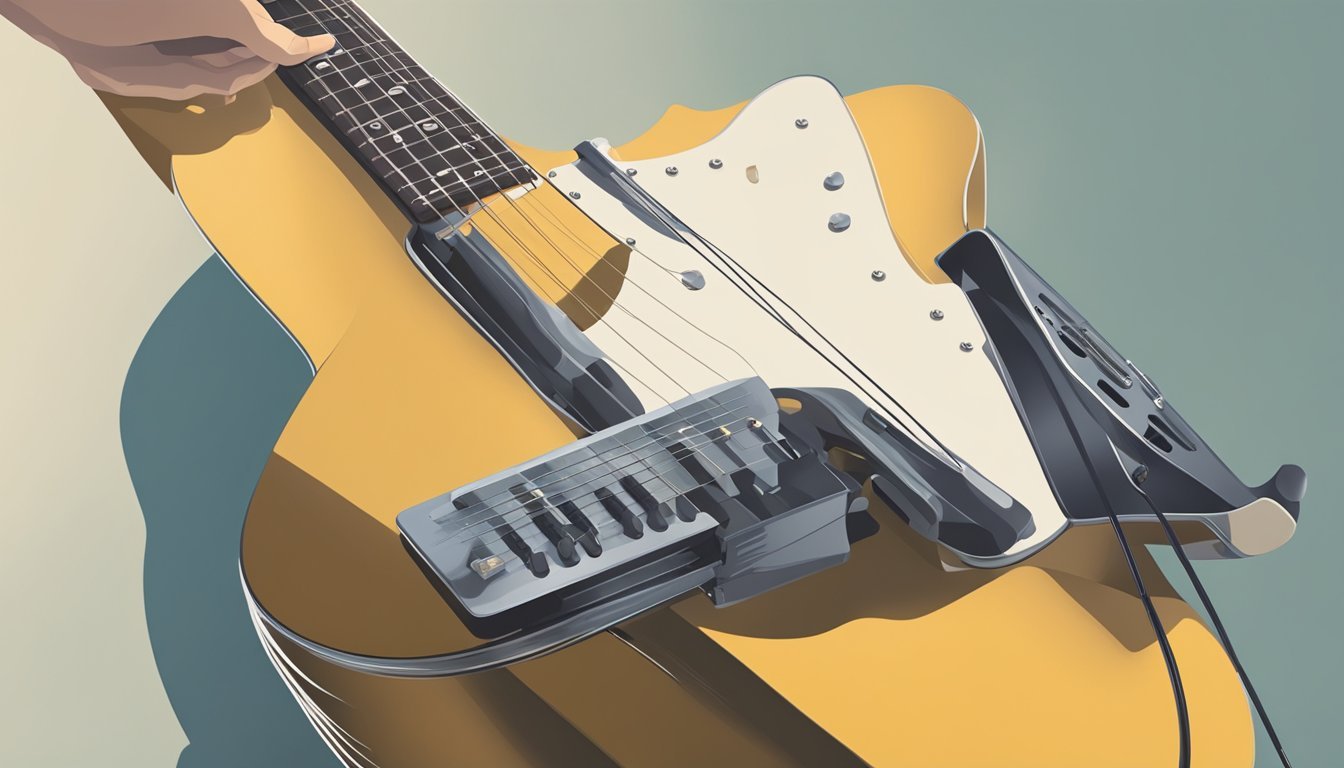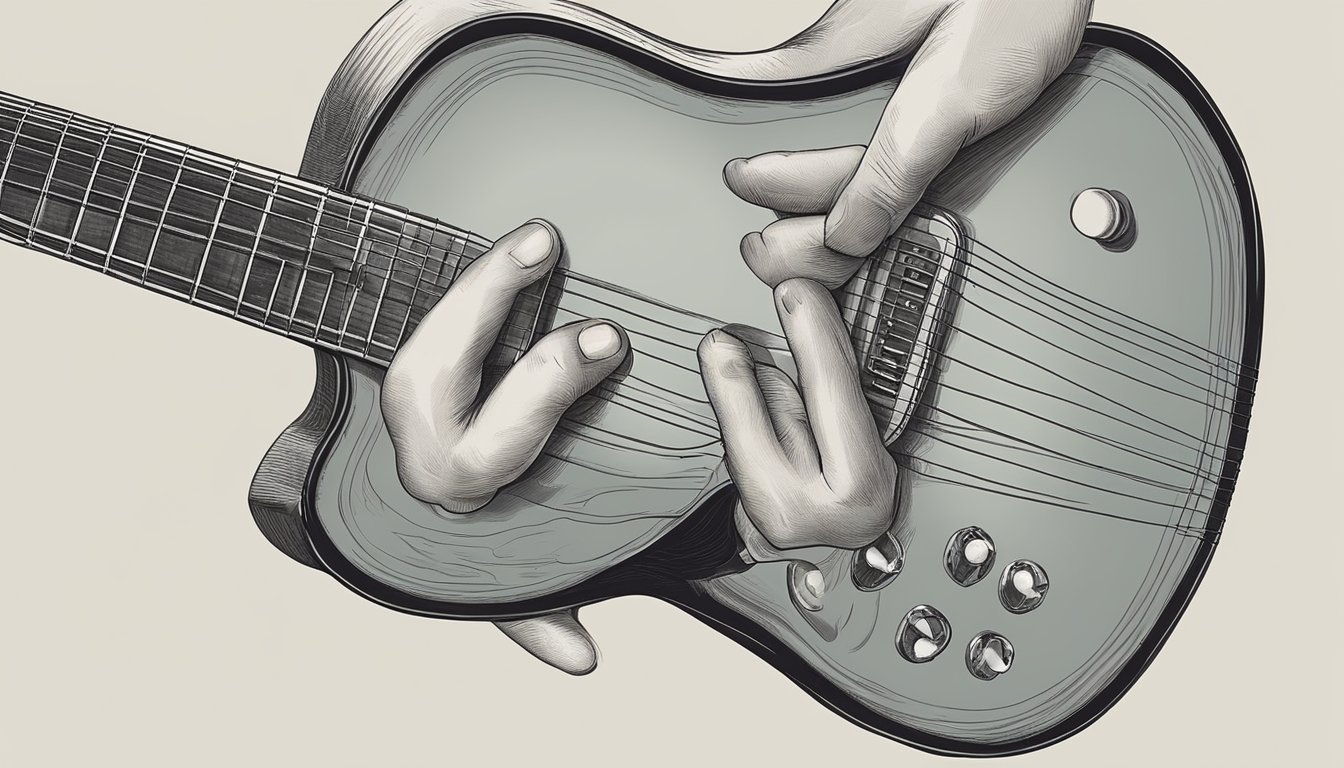When you pick up your guitar and strum a chord, do you ever wonder, “What chord is this?” Understanding chords is essential to mastering the guitar. Knowing how to identify chords can open up many musical possibilities for you. Whether you are learning a new song or creating your own, understanding chords is essential to mastering the guitar.

In this post, you’ll find helpful tips and tools to decode the chords you encounter.
You’ll discover how to identify different chord shapes and make sense of the notes you’re playing.
By the end of this article, you’ll feel more confident in naming those mysterious chords and using them in your playing.
Key Takeaways
- You can easily learn to identify chords on your guitar.
- Various tools can help you understand chord structures and names.
- Practicing chord recognition enhances your overall music skills.
Decoding the Basics

Getting familiar with guitar chords can make your playing much easier and more enjoyable.
By breaking down what a chord is, the notes involved, and how music theory plays into it, you’ll gain a clearer picture of how to identify chords quickly.
What Is a Guitar Chord?
A guitar chord is a group of notes played together.
Typically, chords are made up of three or more notes, which are played at the same time.
For example, a C major chord consists of the notes C, E, and G. When you strum these notes together, you create a harmonious sound.
Chords can be major, minor, diminished, or augmented, depending on the quality of the sound they produce.
Learning basic chord shapes and finger placements on the guitar will help you play many songs.
To expand your musical repertoire, it’s essential to explore different chord progressions and their emotional impacts.
As you practice, you might find yourself asking, “what chord is this on guitar? ” when encountering unfamiliar shapes.
Understanding the theory behind these chords will not only enhance your playing skills but also boost your songwriting abilities.
Understanding Guitar Notes
To grasp guitar chords, you first need to know the individual notes.
The standard tuning of a guitar from the thickest to the thinnest string is E, A, D, G, B, and E.
Each fret on the guitar increases the pitch of a note.
For instance, pressing down on the first fret of the low E string plays an F note.
Here’s a quick reference of notes on each string:
- E string: E, F, F#, G, G#, A, A#, B, C, C#, D, D#, E
- A string: A, A#, B, C, C#, D, D#, E, F, F#, G, G#, A
- And so on.
Knowing these notes helps you understand where they fit into various chords.
The Role of Music Theory in Chords
Music theory gives you the tools to understand how chords work together.
It explains how different notes combine to create a particular sound.
For example, music theory introduces you to the concept of intervals.
An interval is the distance between two notes.
A major third interval is the space between the first note and the third note of a major chord.
Using music theory, you can also learn how to build chords from scales.
For instance, the C major scale leads to the C major chord when you take specific notes.
Understanding these ideas not only makes it easier to identify chords but also improves your improvisation skills.
Identifying Chords on Your Guitar
If you’re trying to figure out what chord you’re playing, there are several helpful methods you can use.
These include tools to identify the chord, reverse methods to get the chord name from notes, and simply training your ears to recognize different sounds.
Using a Chord Finder
A chord finder is a handy tool for identifying chords on your guitar.
You can use online tools like Guitar Chord Finder or Oolimo’s Chord Analyzer that let you input the notes you’re playing.
Just click on the virtual fretboard to see the chord name.
Many chord finders show various ways to play the chord too.
This can help you find easier fingerings or different voicings that sound nice.
Using these tools is great for beginners.
They can quickly boost your confidence and skill as you learn how different chords can sound together.
Reverse Engineering Chords
If you have a melody but aren’t sure what chords fit, reverse chord finders can help.
Tools like the Chord Identifier allow you to input the notes you play, revealing the chord name associated with those notes.
This technique is super useful for songwriters or anyone looking to match chords with a specific melody.
By finding the right chord, you can better accompany your favorite tunes or create your own.
This method also helps you understand the relationship between notes and chords, making music theory a bit clearer.
Listening and Learning
Your ears are powerful tools for figuring out chords.
Start by listening to your favorite songs and trying to pick out their chords by ear.
This exercise will help you recognize different chord progressions and sounds.
Try playing along with songs you love.
As you work on this, you’ll notice patterns and develop your musical intuition.
You can also compare your played chords with chord charts available online.
Practice often, and soon you’ll be able to identify and play chords without needing to look them up! This skill takes time but can make a huge difference in your playing.
Guitar Chords in Practice
Practicing guitar chords is essential for developing your skills as a musician.
You’ll not only learn how to play chords but also how to apply them in various musical contexts.
Application for Musicians
As a guitarist, knowing how to use chords can change your performance.
Chords form the backbone of most songs, letting you accompany singers or other musicians easily.
Start by practicing basic chords like C, G, and D. These are popular in many genres.
You can find step-by-step exercises to help you gain speed and accuracy.
Once you’re comfortable with a few chords, try playing along with your favorite songs.
This makes practice fun and helps you see how chords fit together.
Exploring Chord Variations
Getting to know chord variations is a great way to enhance your music.
Instead of sticking to basic shapes, learn about major, minor, and seventh variations.
For example, altering the E major chord to an E7 creates a different sound.
You can find charts that show finger placements for these variations.
Use them to explore how changing a note can affect the chord’s vibe.
Adding bass notes to chords can also provide depth.
For instance, playing a G major chord with a bass G in the lowest string gives a richer sound.
Chord Transitions and Progressions
Smooth chord transitions are crucial for sounding polished while playing.
Practice shifting from one chord to another slowly at first.
Consider using a metronome to keep a steady beat.
For example, you might practice moving between G, C, and D. Start slowly, then gradually increase your speed.
Another helpful tip is to play common chord progressions.
For instance, the I-IV-V progression (C-F-G) is frequently used in pop and rock.
It’ll improve your timing and make your playing feel more natural.
Regular practice with transitions will help you improvise better too, allowing you to create your own music more easily.
Resources and Tools
Finding the right chords on your guitar can be made easier with various online tools and mobile apps.
These resources help you identify chords quickly, making practice more effective and fun.
Online Chord Identifiers
Online chord identifiers are great tools for figuring out what chord you’re playing.
You can use web-based chord finders to select notes or position on a guitar fretboard.
Many of these sites display the chord name instantly.
Examples include:
- Chord Identifier: Click on the notes to see the name of the chord you’ve played. Check it out at All Guitar Chords.
- Name That Chord: This interactive tool allows you to select frets and view the name of the chord. You can explore various chords based on your input at Name That Chord.
Using these online tools, you can experiment with different fingerings and get familiar with the chords you’re playing.
Mobile Apps for Chord Finding
Mobile apps provide the convenience of finding chords anywhere you go.
Many apps offer features like chord diagrams, lessons, and even audio playback.
These resources can assist you while you’re practicing or learning new songs.
Some popular apps include:
- Guitar Chord Finder: This app lets you search for chords by naming each one or selecting the notes played.
- Ultimate Guitar: A complete tool for finding chords, tabs, and more, great for guitar players of all levels.
Having a chord finder app on your phone means you’ll always have assistance at your fingertips, making it easier to improve your skills.
Frequently Asked Questions

You might have questions about identifying guitar chords and learning how to play them.
Here are some answers to help you out.
How can I figure out what chord I’m playing on guitar?
To identify a chord, you can use a chord chart.
It shows the finger placements needed for different chords.
Listening closely to how the chord sounds can also give you clues about its name.
Where can I find a guitar chord chart?
You can find a guitar chord chart online for free.
Websites like Guitar Tricks provide charts that include diagrams and video tutorials.
These resources make it easy to learn various chords.
Is there an app that identifies guitar chords from audio?
Yes, there are several apps available that can listen to music and tell you what chords are being played.
Apps like Chordify and Ultimate Guitar offer features that help you identify chords simply by playing a song.
What’s the best way to learn guitar chords as a beginner?
Start with basic chords like C, G, D, and E minor.
Practice switching between them smoothly.
Using online tutorials or chord charts can help you learn more efficiently.
Are there interactive tools to help find guitar chords using the fretboard?
Interactive tools like fretboard apps let you explore chords by clicking on strings and frets.
These tools make it easier to visualize how chords are formed on the guitar.
Can I use tabs to determine the guitar chord being played?
Yes, tabs can help you identify chords.
They show you which frets to press on each string.
By understanding the tab, you can follow along and figure out what chord is being played.

